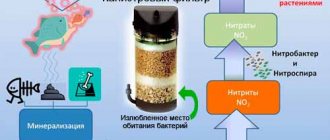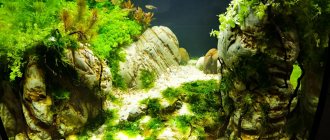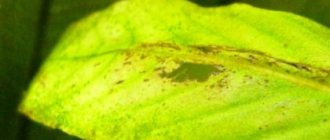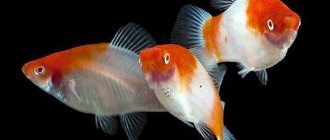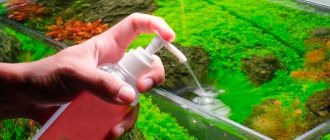One of the healthiest foods is the brown algae kelp. The photo shows that its length reaches 20m. Cooking dishes from it without heat treatment allows you not only to preserve all the beneficial vitamins, minerals and trace elements, but also to experience the special taste and aroma of the product.
What side dish do you prefer with seafood?
- Potatoes 30%, 343 votes
343 votes 30%343 votes - 30% of all votes
- Without garnish 25%, 293 votes
293 votes 25%
293 votes - 25% of all votes
- Fresh vegetables 22%, 249 votes
249 votes 22%
249 votes - 22% of all votes
- Stewed vegetables 14%, 165 votes
165 votes 14%
165 votes - 14% of all votes
- Cereals 9%, 103 votes
103 votes 9%
103 votes - 9% of all votes
Total votes: 1153
18.04.2020
- Potatoes 30%, 343 votes
343 votes 30%343 votes - 30% of all votes
- Without garnish 25%, 293 votes
293 votes 25%
293 votes - 25% of all votes
- Fresh vegetables 22%, 249 votes
249 votes 22%
249 votes - 22% of all votes
- Stewed vegetables 14%, 165 votes
165 votes 14%
165 votes - 14% of all votes
- Cereals 9%, 103 votes
103 votes 9%
103 votes - 9% of all votes
Total votes: 1153
18.04.2020
×
You or from your IP have already voted.
Origin of brown algae, symptoms of formation
Brown algae are members of the Diatoms division (Bacillariophyta). They should not be confused with brown seaweed (Phaeophyta), which includes kelp. In an aquarium, these algae do more harm than good and must be combated.
Diatoms form dusty brown deposits on the walls of the tank. It appears everywhere - on the ground, on driftwood, on filters, on glass, even on plant leaves. Initially, the formation is almost invisible, but later it takes on a dark, rich hue.
At the initial stage, this type of algae is easily removed with a scraper, and even flakes off the plants. If you shake the decoration, a lot of dusty particles will fall off it. Dust can be wiped off with a regular rag soaked in running water, but without using detergents or soap.
But in a neglected reservoir, the fight against diatoms will be difficult. Brown particles turn black and grow quickly, forming growths on all surfaces. The top layer crumbles away, but the bottom remains. It resembles a surface crushed by earth; through the front glass, brown algae is almost invisible.
The problem is that such diatoms negatively affect the health of plants and fish. Plants cannot carry out photosynthesis and practically “suffocate”, and fish do not receive enough nutrients from the water and can become poisoned. If you do not deal with the problem in a timely manner, the consequences will be disastrous for all living creatures.
Places of distribution
Brown algae are species that prefer the sea. However, representatives of four genera prefer to live in fresh water bodies - Heribaudiella, Pleurocladia, Bodanella and Sphacelaria.
These plants are found everywhere in all seas of the globe, but their maximum concentration occurs in water bodies of temperate latitudes, as well as in the subpolar zones. Individual representatives form a significant part of the flora of salt marshes.
It should be noted that brown algae are giants that have chosen the Atlantic Ocean as their habitat. They formed a whole sea there, named Sargasso in their honor. This is Sargassum algae.
That is, climatic conditions are not so important for the life of such plants, which is why their distribution is so wide and widespread.
Body structure of brown algae
Brown algae attaches to rocks and stones, most species are marine. Types of body structures in brown algae: filamentous, heterofilamentous, tissue. The filamentous body consists of several mononuclear branched filaments. Variegated brown algae resemble strings. The body of algae can be annual or perennial. The body of a tissue type structure can have different shapes: in the form of a ball, in the form of a bag, or a plate. Some brown algae have bubbles in their bodies that help them maintain an upright position.
In the less developed, the body is formed by two tissues: the cortex and the core, in the more developed - four: the cortex, meristoderm, intermediate tissue and core. Brown algae can grow in several ways. Diffuse method - most cells can divide. Apical - only the cells of the apex divide. Trichotallic - dividing, cells form hairs above the body. Intercalary - meristem tissue cells grow up and down. Meristodermatic - growth due to special surface tissue.
Brown algae contains alginic acid salts and pectin substances. Because of this, cell membranes may be in a gel-like state. In many countries, brown algae is actively consumed as food, because it is rich in minerals.
Cells in brown plants have 1 nucleus. A reserve product, the polysaccharide laminarin, is deposited in the cells. Cell walls contain cellulose. Is brown algae really dangerous?
Despite the fact that brown algae are considered the most harmless enemies, it is imperative to fight them. First they appear on the glass, then they occupy bottom stones, decorative soil and other decorative items, and then they turn the glass tank into a place where neither fish nor plants can exist.
That is why, at the first signs of “impudent tenants,” you should develop an action plan to eliminate them. Moreover, the fight against brown algae in an aquarium in the early stages is not particularly difficult.
Brown algae in the aquarium - fight
The fight against brown algae in an aquarium begins with increasing the lighting intensity and raising the water temperature to 26-28° degrees. If LD fluorescent lamps are used for lighting, then they must be replaced with LB brand, because LB contains red rays of the spectral composition of light necessary for normal plant growth.
Next, in order to quickly get rid of brown algae, you will have to manually work hard and remove as much algae as possible from the aquarium. It is necessary to clean glasses from brown algae with a scraper or blade, but not with a foam sponge because the algae removed with a sponge will dissolve in the water and greatly pollute the water, adding additional work such as changing the water.
Films of brown algae that have settled on the bottom and are cleared off with a blade must be removed with a soil cleaning hose. Brown algae deposits from plant leaves are cleaned with your fingers by rubbing each leaf in your hand. This must be done carefully so as not to damage the delicate leaves and stems of the plants. You can clear the soil of algae by loosening it shallowly, and it is advisable to remove large stones from the aquarium and wash them under the tap.
It is also necessary to rinse the filter and compressor hoses. After completing the entire procedure, it is advisable not to turn off the light in the aquarium at night for several days to increase the length of daylight hours and more quickly awaken the plants and show signs of rapid growth.
To get rid of brown algae once and for all, you need to get one or two Ancistrus catfish. Ancistrus are also called cleaners or stickers. By feeding on algae, these fish are able to keep the aquarium clean. When a pair of ancistrus lived in my 150 liter aquarium, the walls of the aquarium and the plants were always clean.
But time passed, and the ancistrus outlived their days, and that’s when the problems with brown algae began. Aquarium fish Ancistrus rightfully deserve respect for the cleanliness in our aquariums, and if you want to get rid of brown algae forever, get Ancistrus catfish.
What harm do they do?
Each type of aquarium pest causes its own particular harm to the habitat of underwater inhabitants.
Diatoms
These single-celled organisms have a durable shell consisting of silicon compounds. They do not pose any particular danger to the inhabitants of the home underwater world. Their harm is more of an aesthetic nature. Many fish, shrimp and even some types of snails will not mind eating them.
Euglena algae
They are called green turbidity and are compared to water blooms. Euglenaceae become dangerous for aquarium inhabitants at night. This is due to the fact that in the dark they actively consume oxygen and release carbon dioxide.
Green spot algae
They look like bright green dots on a variety of surfaces. They can be separate or merge into one continuous plaque. Over time, this algae forms a dense coating that is very difficult to remove.
Green filamentous algae
Long cobweb-like or short fleecy threads of bright green shades can fill the entire “fish house” in the shortest possible time.
Blue-green algae
During their life, these plants form a continuous coating of blue-green color, characterized by an extremely unpleasant odor. They release a toxin that is dangerous to animals into the water and contribute to the accumulation of high levels of nitrates in the water.
Red algae
“Black beard”, which looks like short and dense threads, “deer horn” - long branch-like formations and “flip-flop”. All of them use the stems and leaves of aquarium higher plants as their habitat. Algae begin to suffer from lack of nutrition and light, which can lead to the death of the entire plant.
Preventive measures
To avoid having to deal with such a scourge as brown algae again, follow the basic rules for caring for your home ponds.
- First of all, ensure that every corner of the aquarium has sufficient lighting. If daylight hours are too short, use additional lighting fixtures. It is better to use lamps that produce red spectral light.
- Always keep the temperature in the pond at the optimal level (+22-280C) - brown algae like just the opposite, cooler.
- Change the water in the aquarium regularly, monitor its technical indicators (pH levels, iodine, nitrates, phosphates, silicates). Never use water directly from the tap - only purified water is needed.
- Install filters in the pond that can absorb silicates
- Plant the aquarium with a large number of aquatic plants - they will “take away” part of the nutrition from the brown algae, thereby slowing down its growth.
- Experienced aquarists recommend placing zinc and copper products on the bottom of the reservoir. These metals can destroy brown algae.
Every time you change the water or clean the aquarium from brown algae, provide the inhabitants of the reservoir with round-the-clock lighting for several days.
Meaning.
The importance of brown algae in nature and human life is great. They are the main source of organic matter in the coastal zone of the seas. In the thickets of these algae, which occupy vast areas, many marine inhabitants find shelter and food. In industry, they are used in the production of alginic acids and their salts, to obtain feed flour and powder for the manufacture of medicines containing high concentrations of iodine and a number of other microelements. In aquariums, the appearance of brown algae is associated with insufficient lighting. Some species are eaten.
Sargassum
Brown algae also includes plants such as Sargassum. The thallus reaches a length of up to 10 m; its peculiarity is the ability to form air cones and bubbles at the tops. Thanks to this, plants form entire thickets at the surface of the water (in the Sargasso Sea part of the Atlantic Ocean). Attaches to rocky bottom surfaces.
The main areas of application of these species are for human food (Asian countries), animal feed, and extraction of medicinal substances. Habitat: tropical zones.
Reproduction
ALL TYPES OF ALGAE AND THE FIGHT WITH THEM, PHOTOS.
Reproduction in brown algae can occur in the following types: vegetative, sexual, asexual. Vegetative propagation – with random fragmentation of the algae body. Asexual reproduction is characteristic of most brown algae. It occurs with the help of motile zoospores. Zoospores mature in special cells after several nuclear divisions. In the external environment, zoospores actively move for several minutes, after which they shed their flagella and germinate on the substrate.
Most brown algae alternate between 2 generations during their life cycle: gametophyte and sporophyte. The gametophyte resembles a collection of threads, its products are male and female reproductive cells. Merging, they give rise to the sporophyte. The sporophyte will produce spores from which the gametophyte will subsequently develop. Brown algae have pheromones that help them reproduce. They stimulate the release of male germ cells and attract them to female ones.
Characteristic
The presented variety of diatoms is a collection of simple microorganisms. The structure is not very complicated: two parts connected together. The upper one is called the epitheca, the lower one is called the hypotheca. Enclosed in a common shell, a kind of shell. Metabolism is carried out using the porous structure of the protective cover.
Like all protozoa, algae reproduce by cell division. Having separated, the newly formed brown cell takes part of the armor covering belonging to the “mother”, and this is how they multiply. The inability to increase the size of the shell leads to small sizes during reproduction. However, this does not prevent you from capturing larger surfaces. The secretion of mucous secretion promotes the expansion of reproduction.
You can notice the presence of the enemy on plants by a dusty brown coating (hence the name), which is faintly noticeable at the beginning of infection and, as it develops, acquires a more brown color and a pronounced tone.
Development begins in shaded areas of the underwater environment with a large amount of organic sediments. The stronger the infection, the more difficult the existence of the main inhabitants of the aquatic world.
